#saasapplications
Explore tagged Tumblr posts
Text

Looking to Launch Your SaaS Application? Your Success is Our Priority
We specialize in delivering the best SaaS application development projects with 100% client satisfaction.
We provide:
Custom SaaS Application Development
Expert Guidance and Consultation
100% Client Satisfaction
Get a Free Consultation today!
#ConnectInfosoft#SaaS#SaaSDevelopment#SaaSCompany#SaaSService#SaaSDeveloper#SaaSTeam#SaaSApplications#SaaSApplicationDevelopment#SoftwareAsAService#CloudSolutions#SoftwareDevelopment#SaaSExperts#SaaSIndustry#SaaSBusiness#SaaSSolutions#SaaSProducts#CloudDevelopment#SaaSProviders#CustomSaaS#SaaSTech#SaaSStartups#SoftwareEngineers#SaaSGrowth#SaaSPlatform#SaaSTools#SaaSServices#SaaSDevTeam#usa#india
1 note
·
View note
Text
What is SaaS?

SaaS, or Software as a Service, is a cloud-based software delivery model. It allows users to access software applications over the internet, eliminating the need for local installations. This makes it easy to use, maintain, and scale, as the software provider handles updates and security.
0 notes
Text
Chrome Enterprise Boosts Google Workspace Control, Workflow
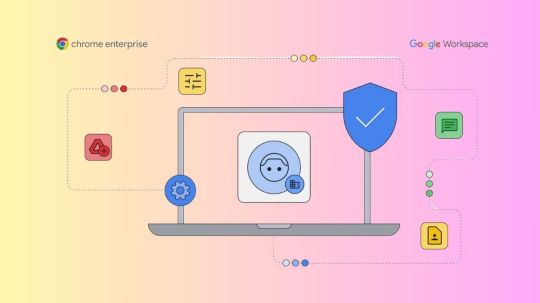
Chrome Enterprise Enhances Google Workspace Users’ Management and Productivity Capabilities
Chrome Enterprise
The browser has become the main point of access for corporate apps and data in today’s mixed work environments. For IT administrators responsible for maintaining and safeguarding this vital access point, this offers both possibilities and difficulties. This is especially more relevant for companies using Google Workspace to promote real-time communication and collaboration, as Workspace applications like Gmail and Google Docs operate entirely within the browser without the need for separate desktop clients.
To ensure that their users are productive, IT administrators must control the access point and select the ideal workspace. At the machine, user, and profile levels, Chrome Enterprise already provides several levels of management. We’ll talk about new profile management tools for IT teams and enhanced Workspace user productivity in this release.
Enhancing Workspace clients’ Chrome profiles and profile administration
In order to provide administrators with even more power and flexibility, Chrome Enterprise keeps improving its profile management features for Chrome users who are logged in. There are several advantages for administrators who choose to manage their fleet at the profile level.
Customization and Fine-Grained Policy Controls: Configure Chrome preferences and rules according to particular user roles or groups in your company.
Enhanced Security and Compliance: Make sure sensitive data is safeguarded even while using personal devices by enforcing security regulations at the profile level (BYOD).
Perfect for Extended Workforce and Personal Devices: On privately owned or contracted devices, offer a controlled and safe browsing environment without jeopardizing user security or privacy.
Allow users to keep separate work and personal profiles, which will increase productivity and enhance the user experience. This will allow for a clear separation of work and personal data.
Customers of Workspace may now access new profile listings and reporting with Google Cloud Identity to gain greater insight into Chrome user profiles within their company. Detailed reports about user profiles inside your business, such as browser version, policies that have been applied, extensions that have been installed, and more, are available in one unified view. Later this year, this feature will be made generally accessible.
For context-aware access, administrators can also take advantage of the new Device Trust Connectors with Okta, Ping, and Cisco Duo. When a user is signed in to Chrome, or when they are in a Chrome Profile, Chrome can share device signals with partners. This frees up administrators from having to maintain the device to create context-aware access controls for their expanded workforce. Customers of Workspace can limit access to Workspace and other SaaS applications and exchange signals by using Workspace context-aware access restrictions or Chrome Enterprise Premium.
It also introducing a new Chrome sign-in flow in the upcoming weeks that will provide business users greater transparency, enabling them to distinguish more easily between their personal and work Chrome profiles and making it easier for them to recognize that they are using a managed browser. Business users will now be able to see what kinds of data are accessible to their organization and how their device and profile are handled. Additionally, users have the option to transfer any already-existing bookmarks, extensions, or other browser data from their personal profile to their work profile or leave it alone.
Better navigation and tab experiences
Employee productivity is enhanced by enterprise browsers, and its team is always striving to make online browsing more user-friendly and productive.
Workspace users now have simple access to their calendar and virtual meetings by opening a new tab and seeing an overview of their daily Google Calendar in addition to the existing customization options for tab pages and the interaction with Google Drive. Keep an eye out as this functionality is still being rolled out!
By using site search shortcuts, you can search for a certain website using the address bar instead of going directly to the website’s URL. Admins can now add site shortcuts to your users’ accounts to quickly access the most important business websites. These can be customized for particular groups, like providing quick access to Salesforce for the whole sales staff. All managed users will be able to access this capability, even if they aren’t using Workspace, as it is currently being rolled out.
Lastly, it has updated tabs that are better for all users on all platforms:
It added the ability to manually save and sync your tab groups in Chrome desktop so you could access them from a different computer last year. These days, your groups automatically sync and save on all of your devices, allowing you to effortlessly resume your browsing session on any device. On PC, Android, and iOS Chromebooks will soon have this feature.
Additionally, Chrome is experimenting with making recommendations for pages to view again based on the tabs you have open on other devices. This can be especially useful if you wish to continue your internet browsing from a different device while commuting home after leaving the office. Through the Chrome New Tab page, Chrome will proactively recommend pages to revisit.
Start using Chrome Enterprise Core, its cloud management tool, to set and configure many of the features we’ve discussed today.
Chrome Enterprise pricing
Pricing for Chrome Enterprise usually varies based on the plan or subscription model that companies select. The main Chrome Enterprise pricing schemes are summarized as follows:
Chrome Enterprise upgrade: The annual cost of this update is around $50 USD per device. It makes it simpler for businesses to manage their Chrome fleet by unlocking increased security features and advanced management capabilities for Chrome OS devices.
Chrome Enterprise Plus: This is a more complete package that might include with tools for large-scale deployments, security features, and enhanced support. Pricing is typically tailored according to the size, quantity, and particular requirements of the organization’s devices.
Perpetual Licenses: This model is less frequently publicized, however certain organizations may choose to offer perpetual licenses with a one-time charge structure.
It is advised to get in touch with Google sales or a Google Cloud partner for a tailored quote in order to find out the precise cost for your company’s requirements.
Read more on govindhtech.com
#ChromeEnterpriseBoost#GoogleWorkspaceControl#ChromeEnterprise#GoogleDocs#securityregulations#GoogleCloud#SaaSapplications#GoogleDrive#Chromedesktop#ChromeEnterprisepricing#news#technology#technews#govindhtech
0 notes
Text
AppOmni Harnesses Google Data Centre In Australia To Address Regional Demand For Specialised SaaS Security Solutions
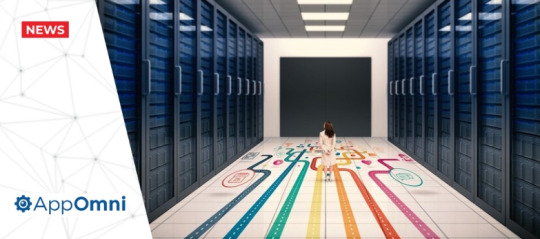
AppOmni, a leader in SaaS security posture management (SSPM), recently announced the opening of a new data center powered by Google Cloud Platform (GCP) in Sydney, Australia. Through this initiative, Australian businesses—private or public—that must abide by the nation's data sovereignty laws, such as the Privacy Act and the Australian Privacy Principles, will have access to AppOmni's all-inclusive SaaS security solutions.
Australia is a key region for AppOmni as it continues its global expansion ambitions. The Asia-Pacific (APAC) region's growing requirement to defend against sophisticated threats aimed at SaaS applications is met by the new data center. For the 25% of Fortune 100 businesses who already depend on AppOmni to secure their SaaS ecosystems, the move is very pertinent.
With an emphasis on SaaS Security Posture Management, AppOmni's platform helps security teams and SaaS application owners protect sensitive and mission-critical data from internal threats and attackers. In order to offer comprehensive data access visibility, secure identities and SaaS-to-SaaS connections, threat detection, prioritized insights, and streamlined compliance reporting, the platform continuously monitors SaaS APIs, configurations, and audit logs.
Read More - bit.ly/3SKt0O4
#AppOmni#ComputerAndNetworkSecurity#GoogleCloudPlatform(GCP)#SaaSSecurityPostureManagement#SaaSApplications#SaaS-to-SaaSConnections
0 notes
Text

Rexett is a premier SaaS application development company, delivering scalable, secure, and high-performance cloud-based solutions tailored to your business needs. Our expert team specializes in building cutting-edge SaaS applications that enhance efficiency, streamline operations, and drive digital transformation. Whether you need a custom SaaS platform, API integration, or cloud migration, Rexett ensures a seamless development process with innovative technology. Partner with us to unlock the full potential of SaaS application development services and stay ahead in the competitive digital landscape.
0 notes
Text
Innovate, Develop, Succeed: The Key Ingredients for SaaS App Development
"Innovate, Develop, Succeed: SystimanX's philosophy for #SaaSappdevelopment excellence. With our expertise, businesses navigate innovation pathways to achieve digital success."
#saasdevelopment#saasappdevelopment#saasapplication#SaaSdevelopmentcompany#SaaSdevelopmentservices#SaaSsoftwaredevelopment#CustomSaaSsolutions#`
0 notes
Text
Digital Insights Newsletter - Telliant Systems
We're excited to announce the release of our latest newsletter "Digital Insights"! Discover fresh insights, updates, and inspiration in every issue. Click the link to read it now.
#newsletter#signup#softwaredevelopment#web3#web3technology#web3tech#techstack#SaaS#SaaSapplication#cloudservices#cloudprovider#knowledgetransfer#apimanagement#api#technologytrends
0 notes
Text
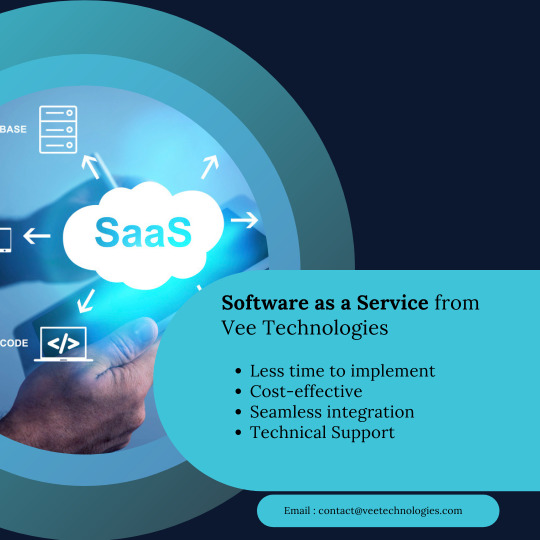
Software as a Service Company - New Zealand
Customized Software as a Solutions (SaaS) from Vee Technologies offers a comprehensive and advanced infrastructure that is aligned with global standards and compliance.
Email : [email protected] Visit : https://bit.ly/3Q4HVS4
#NewZealand#SAASDevelopers#SAAS#SoftwareSolutions#SAASApplication#softwareapplication#saascompanies#saassoftware#NewZealandsoftwarecompanies#NewZealandsaascompany
0 notes
Text
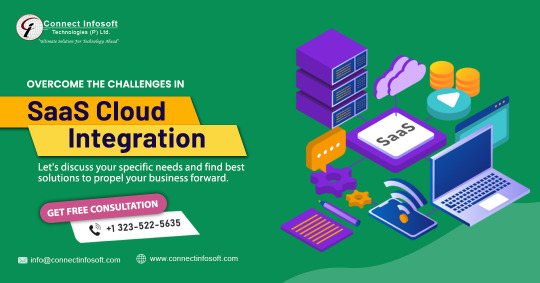
Overcome the Challenges in SaaS Cloud Integration
Let's discuss your specific needs and find best solutions to propel your business forward.
With years of expertise, our team has honed the art of integrating diverse SaaS applications into a cohesive ecosystem, ensuring smooth operations and maximizing efficiency.
#connectinfosofttechnologies#saasdevelopment#SaaSCloudIntegration#saasapp#saasdev#saascompany#saassolutions#cloudapps#softwareasaservice#customsaas#saasexpertise#clouddevelopment#softwaredevelopment#saasdeveloper#appdevelopment#cloudcomputing#saasexperts#agiledevelopmentsaasapplicationdevelopmentservice#saasapplicationdevelopment#saasapplication#saas#saasapplicationdevelopmentcompany#saasapplicationdevelopmentteam#saasapplicationdeveloper#saasapplicationdevelopmentexpert#itconsultant#itcompany#itindustry#itservices#usa
1 note
·
View note
Text
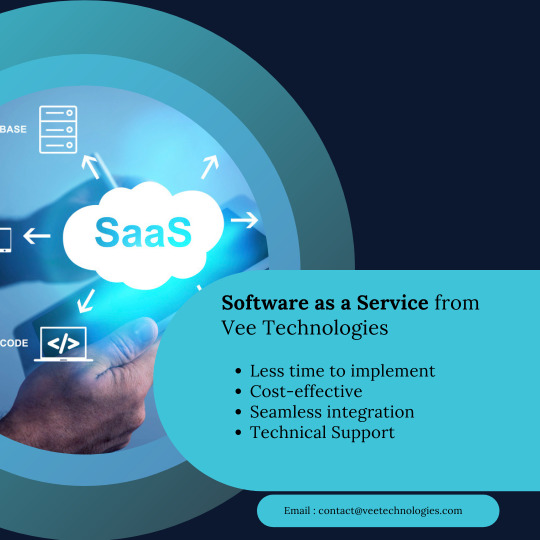
Software as a Solutions (SaaS)
Customized Software as a Solutions (SaaS) from Vee Technologies offers a comprehensive and advanced infrastructure that is aligned with global standards and compliance.
Email : [email protected] Visit : https://bit.ly/3Q4HVS4
#NewZealand#SAAS#SAASDevelopers#Software#Developer#SoftwareSolutions#SAASApplication#softwaredevelopment#softwareapplication#saascompanies#saassoftware#NewZealandsoftwarecompanies#NewZealandsaascompany
0 notes
Link
Take a closer look at the Six Things to Consider while developing a SaaS application before you begin your road to designing SaaS application. With SaaS, users can easily access cloud-based applications even if they aren’t locally installed, creating a whole new world of possibilities.

#saas#saasapplications#saasdevelopment#softwareasaservice#saasdevelopmentcompany#saasdevelopers#developingasaasapplication#creolestudios
0 notes
Text
SaaS Security Risks: Protecting Your Data in the Cloud

SaaS cloud security
SaaS has altered businesses with its cost-effectiveness, scalability, and ease. Online SaaS systems enable email, collaboration, CRM, and ERP. As SaaS use grows, so do security issues. This article examines SaaS security risks and offers solutions.
SaaS security issues
Illegal Access and Data Breach
Summary of Risks
Data leaks are a major SaaS security risks. Unauthorised access might result from inadequate access restrictions, weak passwords, or SaaS provider infrastructure flaws. An attacker can ruin operations, disrupt services, or steal data once inside.
Mitigation Plans
Use multi-factor authentication (MFA) in addition to passwords for security.
RBAC controls access to ensure users can only access the information and services they need.
Perform regular security audits and vulnerability assessments to detect and resolve system issues.
Problems with Data Integrity and Loss
Summary of Risks
Data loss can arise from malware, system failures, or accidental deletions. Data integrity issues changed or corrupted data can also compromise company procedures.
Mitigation Plans
Backup data regularly and have restore capabilities in case of loss or damage.
Encrypt data in transit and at rest to prevent unauthorised access and modification.
Develop and test disaster recovery plans to ensure company continuity after data loss.
Difficulties with Regulatory Compliance
Summary of Risks
There are several industry and regional legislation (like GDPR and HIPAA) that pertain to data security and privacy. Serious fines and harm to an organization’s reputation may arise from noncompliance.
Mitigation Plans
Recognise Requirements: Be aware of any applicable laws and make sure your SaaS provider abides by these guidelines.
Audits of compliance: Verify that all facets of data handling and storage adhere to legal standards by conducting routine compliance audits.
Data Sovereignty: Make sure that data is kept in places that abide by laws from the relevant jurisdiction.
Threats from Within
Summary of Risks
Insider risks can originate from workers, contractors, or other reliable individuals who may purposefully or inadvertently jeopardise security. It may be very challenging to identify and counteract these risks.
Mitigation Plans
Staff Education: Conduct frequent training sessions on security best practices and the significance of data protection.
Monitor Access: Use thorough logging and monitoring to find odd or unauthorised access patterns.
Least Privilege Principle: Make sure users have the minimal access required to carry out their responsibilities by adhering to this principle.
Dependency and Vendor Lock-In
Summary of Risks
Saturation of the market with just one SaaS provider can result in vendor lock-in, which makes it challenging to move providers or interact with other platforms. This dependency may present dangers in the event that the supplier has problems or decides to stop providing the service.
Mitigation Plans
Due Diligence: Do extensive study and make sure a SaaS provider will fulfil your long-term requirements before choosing them.
Select vendors who promote data portability and provide interoperability with other systems.
Exit Strategy: Create an exit strategy, including with procedures for data migration, to guarantee a seamless transition in the event that you must change providers.
Shadow IT
Summary of Risks
The term “shadow IT” describes how employees use unapproved SaaS apps. Due to these apps’ potential noncompliance with the organization’s security policies, security risks may result.
Mitigation Plans
Enforcement of Policy: Establish and implement precise guidelines for using SaaS apps.
Awareness Campaigns: Inform staff members about the dangers of “shadow IT” and the value of sticking to approved apps.
IT oversight: Establish systems and procedures to keep an eye on and control SaaS usage inside the company.
Risks Associated with Multitenancy
Summary of Risks
Multiple clients share the same infrastructure while using SaaS apps, which frequently have a multi-tenant architecture. This technique is economical, but there may be hazards if a single tenant’s weaknesses impact other tenants.
Mitigation Plans
Isolation methods: To keep client data and applications distinct, make sure the SaaS provider has strong isolation methods in place.
Testing Frequently: To find and fix any possible cross-tenant vulnerabilities, perform penetration tests frequently.
Make sure that the service level agreements (SLAs) you have with the supplier cover incident response and security procedures.
Security for APIs
Summary of Risks
The integration of SaaS applications with other systems depends on application programming interfaces, or APIs. Attackers may be able to take advantage of vulnerabilities that are exposed by insecure APIs.
Mitigation Plans
Adhere to recommended standards for secure API design, which include appropriate authorization, authentication, and input validation.
Frequent Testing: To find and address vulnerabilities, test APIs for security on a regular basis.
API Monitoring: Use ongoing API activity monitoring to identify and address questionable activities.
The Stealing of Accounts
Summary of Risks
Unauthorised access to user accounts by attackers leads to account hijacking. Phishing, cramming credentials, and other techniques can cause this. Once the account has been taken over, attackers might use it for evil.
Mitigation Plans
Users should be made aware of phishing and other social engineering attempts in order to stop credential theft.
Account monitoring involves keeping an eye out for odd activity on accounts and setting up automated reactions to possible account takeover attempts.
Robust Password Rules: To improve security, enforce the usage of strong password policies and promote the adoption of password managers.
Poor Reaction to Incidents
Summary of Risks
The effects of security incidents may be worsened by a poor incident response. Greater data loss and damage may result from delays in identifying and addressing breaches.
Mitigation Plans
The creation and upkeep of a comprehensive incident response plan customised for SaaS settings is required.
Conduct routine incident response drills to make sure you’re prepared and to speed up reaction times.
Cooperation: To guarantee a coordinated reaction to issues, promote cooperation between internal teams and the SaaS supplier.
In conclusion
SaaS has many benefits, but firms must be aware of and reduce its security risks. Businesses can use SaaS benefits while protecting their data and operations by being aware of these risks and taking precautions. In addition to technology fixes, a thorough strategy to SaaS security includes staff training, policy, and ongoing monitoring to adjust to changing security risks. Organisations may reduce risk and get the most out of their SaaS investments by being watchful and well-prepared.
Read more on govindhtech.com
#saassecurity#protecting#data#cloud#cloudsecurity#saassecurityrisks#saas#backupdata#dataloss#likegdpr#saasprovider#mitigationplans#apidesign#saasapplications#saasapps#technology#technews#news#govindhtech
1 note
·
View note
Link
With most businesses that are product-based comes the responsibility of manufacturing.
This also comes with challenges as it turns the manufacturing industry scenario into a ruthlessly competitive one. To keep up with challenges the manufacturers need to adapt quickly. In their search for advents that can help them stay ahead of the competition and keep expenses at a minimum most of them turn to ERP, specifically cloud ERP software.
0 notes
Text
How SaaS Vs Traditional Software Make the Startups Thrive
https://blog.undaku.com/how-saas-vs-traditional-software-make-the-startups-thrive
#saas software#saas#saas companies#saas startup#saas solutions#no code#no code app#no code app builder#saas development#saas business#saas platform#saas marketing#saasservices#saas application development#saasapplication#saasproduct#saas provider#no code platforms#nocodeplatform#saascloud#saastechnology#saasproviders#saas company#enterprise saas#saastools#saas development company#agile methodology#agile#saastool#software as a service
2 notes
·
View notes
Text
Bind your systems of record tightly with BM Cloud applications and achieve organizational excellence, while also protecting revenues.
Contact mail id : [email protected] Call us : +1.833.561.3093

#atlantis#systemsofrecord#cloudapplications#revenues#systems#erpsystem#bmcloudapplications#protectingrevenues#erp#pos#informationsystem#cloudapp#saperpsystem#erpsolutions#saasapplication#clouderp#erpcrm#erpenterpriseresourceplanning#erpapplication#saperpsoftware
1 note
·
View note
Photo

Laravel is a practical PHP framework for building Sass applications. Saas is a software distribution model and also third-party host applications. Laravel Web Application Development is one of the popular trends in the market because of its unique features.
#saas#laravel#SaaSApplication#Laravelenablesdevelopers#LaravelSupports#Laravel Development Company in India
1 note
·
View note